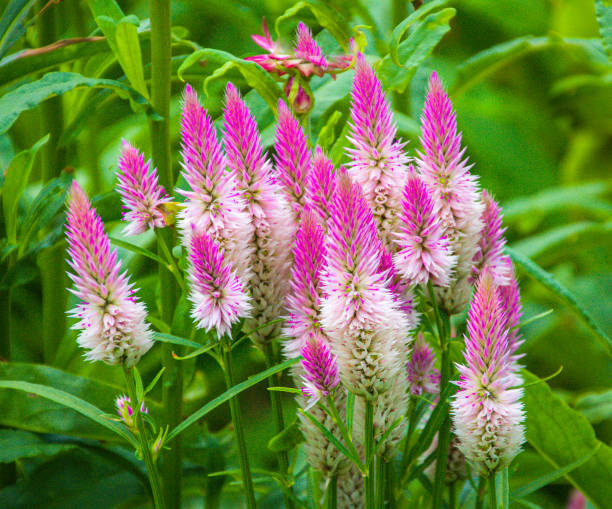

Celosia argentea L.
|
It is commonly known as Sarwari and belongs to the Amaranthaceae family. Leaves, tender shoot and young flower spikes cooked into soups, sauces or stews with various ingrediants together with other vegetables. Celogenamide-A, Celogentin-A-H, J-K, Celosin A-G are some of thenotable bioactive compounds reported from this plant. Mode of Consumption : Cooked into soups, sauces or stews |
| Plant Details | Agro-climatic Zone | Vernacular Names | Pictures |
| Scientific Name: Celosia argentea L. Family: Amaranthaceae Juss. Class: Magnoliopsida Order: Caryophyllales Genus: Celosia L. Fruiting Season: June to October Parts: Leaves, Tender shoot & Young flower spikes |
|
Andhra Pradesh : Gurugaku, Gurugu, Panchechetta Assam : Bhulki Bihar : Sufaid murgha, Sarwari Delhi : Sufaid murgha, Sarwari Gujarat : Lapadi, Lambadi Haryana : Sufaid murgha, Sarwari Jharkhand : Sufaid murgha, Sarwari Madhya Pradesh : Sufaid murgha, Sarwari Maharashtra : Kurdu, Kurada Punjab : Sarwali, Sil, Sarpankha Rajasthan : Sufaid murgha, Sarwari Telangana : Gurugaku, Gurugu, Panchechetta Uttar Pradesh : Sufaid murgha, Sarwari Uttarakhand : Sufaid murgha, Sarwari West Bengal : Swetmurga |
 Plant |
| Compound/Extract | Activity | Mode of Action | Marker/References |
| Leaf extract | Wound healing | Treatment with leaf extract showed better result on burn wound healing in rats than silver sulfadiazine. | [1] |
| Celosian | Immunostimulatory | Co-culture of celosian and Con A increased IFN-γ secretion two-fold compared to Con A alone in mice spleen cells. | IFN-γ[2] |
| Seed extract | Immunomodulatory | Administration of seed extract increased IL-2, IFN-γ production and reduced the production of Th2 cytokine (IL-4) from splenocytes stimulated by phorbol-12-myristate-13-acetate (PMA) and Calcium Ionophore A23187. | IL-2, IFN-γ, and IL-4[3] |
| Major Class | Metabolites (Content of bioactives: mg/100g Fresh Weight) |
| (3Z)-hexenyl-(1-O--rhamnopyranosyl--glucopyranoside): , (3Z)-hexenyl-1-O--glucopyranoside: , (7E)-6,9-dihydromegastigma-7-ene-3-one-9-O-[-glucopyranoside: [12] | |
| Bicyclic peptide | Celogenamide-A: , Celogentin-A: , Celogentin-B: , Celogentin-C: , Celogentin-D: , Celogentin-E: , Celogentin-F : , Celogentin-G: , Celogentin-H: , Celogentin-J: , Celogentin-K: , Celosian: , Citrusin C: , Cristataine: , Moroidin: [4] |
| Carboxylic Acid | Gallic acid: [7] |
| Carotenoid | β- Carotene: [7] |
| Catechol | 3,4-Dihydroxy benzoic acid: [7] |
| Disaccharide | Sucrose: [7] |
| Fatty acid | Arachic acid: , Arachidonic acid: , Hexadecanoic acid: , Linoleic acid: , Linolenic acid: , Octadecanoic acid: , Oleinic acid: , Palmitoleic acid: [9] |
| Flavonoid | 5-Methoxy-6,7-methylene dioxy-2’-hydroxyisoflavone: , Luteolin 7-0 glycoside: , Tlatlancuayin: [4] |
| Glycoside | n-Butyl--d-fructose glycoside: [7] |
| Pentacyclic triterpenoid | Oleanolic acid: [7] |
| Phenol | 4-O-β-d-apifuranosyl-(1→2)--d-glucopyranosyl-2-hydroxy6-methoxyacetophenone: , Epigallocatechin: , Lutin: , Quercetin: , Rosmarinic acid: [7] |
| Phenolic aldehyde | 3,4-Dihydroxyl benzaldedyde: [7] |
| Phenolic compound | (1-(4-hydroxy-2-methoxybenzofuran-5-yl)-3-phenylpropane1,3-dione): [4] |
| Phenolic derivative of benzoic acid | p-Hydroxybenzoic acid: [7] |
| Phytosterol | Stigmasterol: , β-sitosterol: [7] |
| Phytosterol-like compound | Daucosterol: [7] |
| Saponin | Celosin A: , Celosin B: , Celosin C: , Celosin D: , Celosin E: , Celosin F: , Celosin H: , Celosin I: , Celosin II: , Celosin J: , Cristain: [4] |
| Vitamin | Ascorbic acid: [7] |
| Effect | Observation | DOI |
| Disease | Formulation | Reference | Author | TKDL |
| Spermatorrhoea | Safoof Jiryaan | Quaraabaadeen Najm-al-Ghani | Mohd. Najmul Ghani Khan | Unani |
| Semen Inspissant, and Retentive | Safoof Mughalliz | Quaraabaadeen Najm-al-Ghani | Mohd. Najmul Ghani Khan | Unani |
| Information from Wealth of India | Reference |
|
CSIR(1950).The Wealth of India, Raw materials,Vol.-II ,P.113-114, New Delhi, India |
| 4.2, 4.2.1, 4.2.1.1, 4.2.1.3, 4.2.2.8, 4.2, 4.2.1, 4.2.1.1, 4.2.1.3, 4.2.2.8 |
| CSIR-North East Institute of Science and Technology, Jorhat-6, Assam, India
CSIR-Institute of Himalayan Bioresource Technology, Palampur-61,Himachal Pradesh, India |